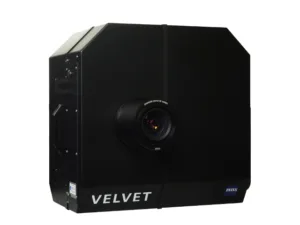One of the surprises at I/ITSEC 2016 was the debut of a projector from Carl Zeiss. Technically, the projector, called Velvet, is not new as it is used in the planetarium market, but the show marked the beginning of a campaign to offer it to the simulation and training market.
The design is also quite unique in that it is a two-DMD design (see diagram for the patent US 8,500,290 B2). The DMDs are both WQXGA resolution with the first one acting as a light modulator and the second as an image modulator. This series architecture means the contrast of each stage can be multiplied resulting in a sequential contrast of 2.5M to one and an ANSI checkerboard contrast of 1000:1 – both extremely impressive results. This design requires very careful pixel scale alignment of the two imagers, however, along with very high quality optics – something Zeiss is well known for. Signal processing is 10 bits per color in the projector and precision blending and warping at low light levels is supported with an optional outboard processor also working at 10 bits per color.

Interestingly, the projector is lamp based and only produces about 1500 lumen of light output. This will clearly limit adoption in this market. Also, there is no separate IR LED for NVG operation. Zeiss says they should be able to get enough IR from the lamp to allow some NVG stimulation but this cannot be controlled separately the way an IR LED can. Since the projector has such great contrast, it is ideally suited for night time training simulations. I believe that Zeiss needs to offer the IR solution soon before it can expect many sales in this market segment. Zeiss says they recognize the limitations and are working on an IR solutions (lamp and LED) now as well as LED and laser phosphor light solutions.
We did get a demo of two of the units using only electronic blending in a very dark room with very dark content and there was no evidence of a brighter blend zone in the middle. That’s impressive.
The company’s business model is to not sell the projector only, but to sell simulation solutions which means they will need to partner with an integrator, screen provider, calibrator, IG provider and more. – CC

